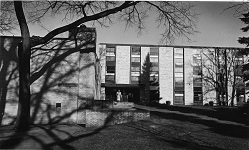 The construction of Park Region Hall in the mid-1950s as a women’s dormitory was part of Concordia’s response to increasing post-WWII student enrollment as well as the availability of government loans. From 1951 to 1955 the college’s enrollment increased by fifty-two percent, with 1354 students registered for the 1955-56 academic year. In addition to providing a new housing option for students, Park Region Hall experimented with a new form of residence governance that was eventually adopted across campus. In the twenty-first century the dormitory remains a place to test new ideas. During the 2016-2017 academic year Park Region was the first Concordia dormitory to offer a sexuality- and gender-inclusive floor. The construction of Park Region Hall in the mid-1950s as a women’s dormitory was part of Concordia’s response to increasing post-WWII student enrollment as well as the availability of government loans. From 1951 to 1955 the college’s enrollment increased by fifty-two percent, with 1354 students registered for the 1955-56 academic year. In addition to providing a new housing option for students, Park Region Hall experimented with a new form of residence governance that was eventually adopted across campus. In the twenty-first century the dormitory remains a place to test new ideas. During the 2016-2017 academic year Park Region was the first Concordia dormitory to offer a sexuality- and gender-inclusive floor.
|
 In 1968, Concordia College opened Hallett Hall, an all-women’s dormitory, along with Erickson Hall, an all-men’s dormitory. The dormitories were built as different sections of one complex. It was the first time since the college’s very early years, when its single building was home to both sexes by necessity, that men and women lived in such close proximity. Hoyum Hall was a former women’s dormitory that became the first building on campus to house both male and female students in 2008. In 1968, Concordia College opened Hallett Hall, an all-women’s dormitory, along with Erickson Hall, an all-men’s dormitory. The dormitories were built as different sections of one complex. It was the first time since the college’s very early years, when its single building was home to both sexes by necessity, that men and women lived in such close proximity. Hoyum Hall was a former women’s dormitory that became the first building on campus to house both male and female students in 2008.
|
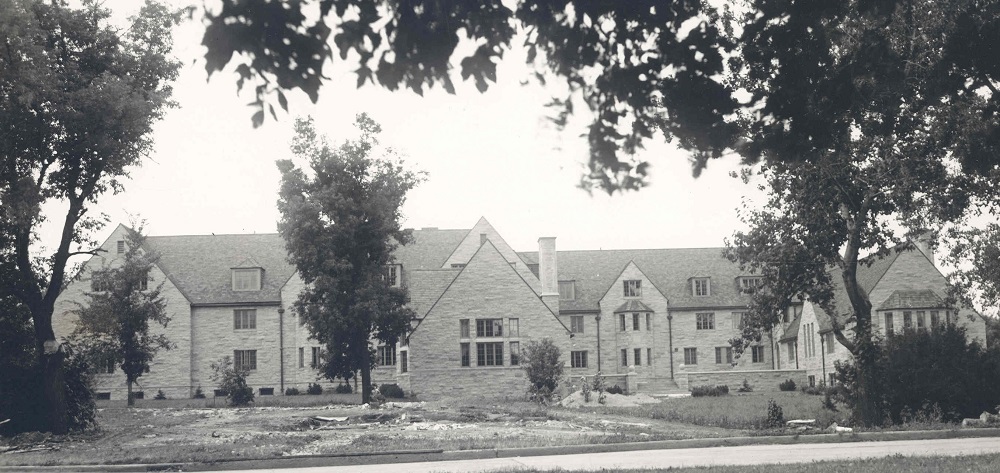 Fjelstad Hall was built on Concordia’s campus in the late 1930s as a new women’s dormitory. One of the most attractive buildings on the college grounds, it provided female students comfortable accommodations and supervision while they were away from home. Though periodically remodeled and updated, the dormitory was used consistently for female campus housing until 2014. Fjelstad Hall was built on Concordia’s campus in the late 1930s as a new women’s dormitory. One of the most attractive buildings on the college grounds, it provided female students comfortable accommodations and supervision while they were away from home. Though periodically remodeled and updated, the dormitory was used consistently for female campus housing until 2014.
|
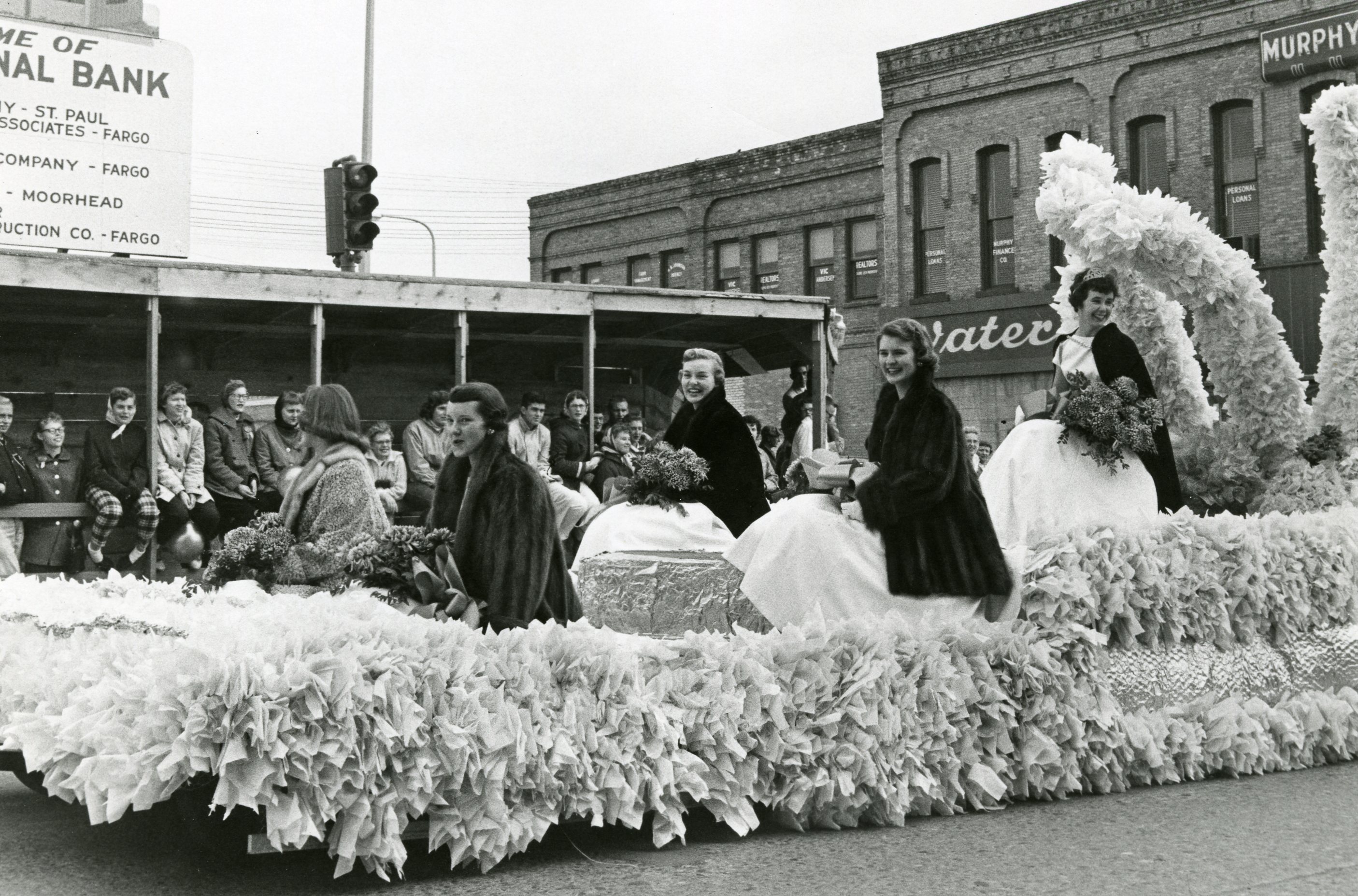 Concordia’s tradition of crowning a homecoming queen began in the 1920s. Student movements and the influence of the 1960-70s society affected the practice. Due to student concerns, the 1974 Homecoming Chairperson Ken Fitzer substituted the tradition of voting for a homecoming queen with the Don Awards, which was a recognition given to four exemplary senior students. The current practice of crowning both a king and queen began during the homecoming festivities in 1977. Concordia’s tradition of crowning a homecoming queen began in the 1920s. Student movements and the influence of the 1960-70s society affected the practice. Due to student concerns, the 1974 Homecoming Chairperson Ken Fitzer substituted the tradition of voting for a homecoming queen with the Don Awards, which was a recognition given to four exemplary senior students. The current practice of crowning both a king and queen began during the homecoming festivities in 1977.
|
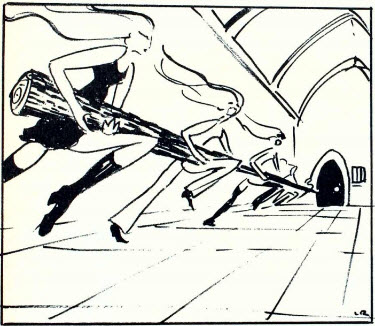 Until the early 1970s, Concordia College imposed restrictive rules and strict regulations pertaining to women’s curfews and lights out. The questioning of authority surrounding the Vietnam War and the feminist movement helped to empower female Cobbers to advocate for their personal freedom. Through a variety of strategies such as demonstrations, lobbying, and expressing opinions in the campus newspaper, women studying at Concordia gained personal freedom and independence when Women’s Hours were eliminated in 1973. Until the early 1970s, Concordia College imposed restrictive rules and strict regulations pertaining to women’s curfews and lights out. The questioning of authority surrounding the Vietnam War and the feminist movement helped to empower female Cobbers to advocate for their personal freedom. Through a variety of strategies such as demonstrations, lobbying, and expressing opinions in the campus newspaper, women studying at Concordia gained personal freedom and independence when Women’s Hours were eliminated in 1973.
|
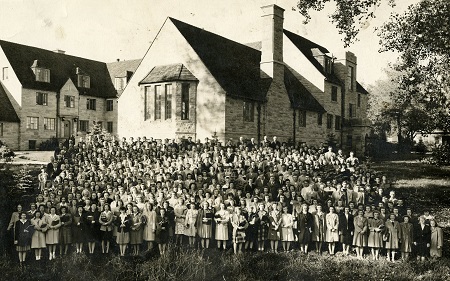 In the midst of World War II Concordia College adapted to wartime restrictions and decreasing enrollment. Due to the military draft the number of male students enrolled dropped, while the number of females attending the college increased dramatically. Accordingly, Concordia established programs and courses that allowed and encouraged women to contribute to the war effort. In the midst of World War II Concordia College adapted to wartime restrictions and decreasing enrollment. Due to the military draft the number of male students enrolled dropped, while the number of females attending the college increased dramatically. Accordingly, Concordia established programs and courses that allowed and encouraged women to contribute to the war effort.
|
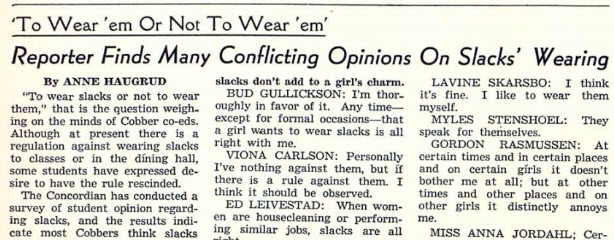 Double standards in the regulation of student conduct at Concordia College placed the liberties of women below those of men. Dress codes and smoking policies in particular explicitly treated female students differently than male students. A combination of student action as well as changing social views brought an end to these sexist differences in regulation over the course of the 1960s and 1970s. Double standards in the regulation of student conduct at Concordia College placed the liberties of women below those of men. Dress codes and smoking policies in particular explicitly treated female students differently than male students. A combination of student action as well as changing social views brought an end to these sexist differences in regulation over the course of the 1960s and 1970s.
|
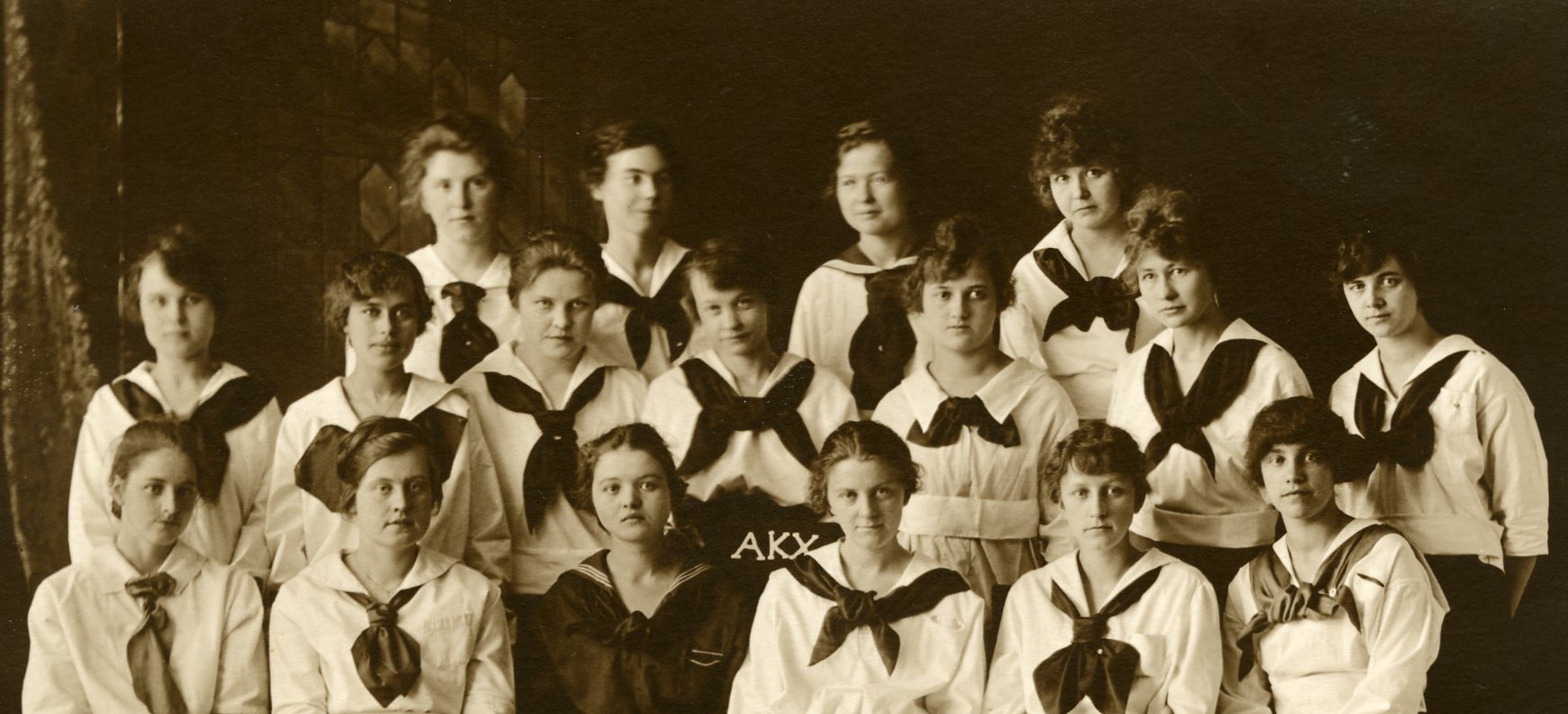 Literary societies were once a common feature at Concordia. Alpha Kappa Chi (AKX) was the first all-female literary society at the college. Even as its focus shifted from literary pursuits to social events to charitable activities, AKX provided a way for Concordia women to engage with their campus and their community for over eighty years. Phi Kappa Chi (PKX) was another major women’s society at Concordia College from 1946 to 1969. Although PKX was relatively short-lived, it provides an interesting look at some of the factors that influenced the rise and fall of women’s (and men’s) societies at Concordia. Literary societies were once a common feature at Concordia. Alpha Kappa Chi (AKX) was the first all-female literary society at the college. Even as its focus shifted from literary pursuits to social events to charitable activities, AKX provided a way for Concordia women to engage with their campus and their community for over eighty years. Phi Kappa Chi (PKX) was another major women’s society at Concordia College from 1946 to 1969. Although PKX was relatively short-lived, it provides an interesting look at some of the factors that influenced the rise and fall of women’s (and men’s) societies at Concordia.
|
 Eric Fontaine attended Concordia College during a period of dramatic racial change in higher education, matriculating in 1970 and graduating in 1974. Stepping from the nation’s capital, Fontaine asserted himself on campus through multiple extra-curricular involvements and leadership positions. He served as a guest editorialist for the student paper and as copy editor of the yearbook. In 1973, Fontaine became the first African American student in the college’s history to be elected Student Association president. Following graduation, Fontaine went on to pursue a wide-ranging career as a human resources professional, providing diversity expertise through consulting, coaching, teaching, and training in industry, government, and higher education. Eric Fontaine attended Concordia College during a period of dramatic racial change in higher education, matriculating in 1970 and graduating in 1974. Stepping from the nation’s capital, Fontaine asserted himself on campus through multiple extra-curricular involvements and leadership positions. He served as a guest editorialist for the student paper and as copy editor of the yearbook. In 1973, Fontaine became the first African American student in the college’s history to be elected Student Association president. Following graduation, Fontaine went on to pursue a wide-ranging career as a human resources professional, providing diversity expertise through consulting, coaching, teaching, and training in industry, government, and higher education.
|
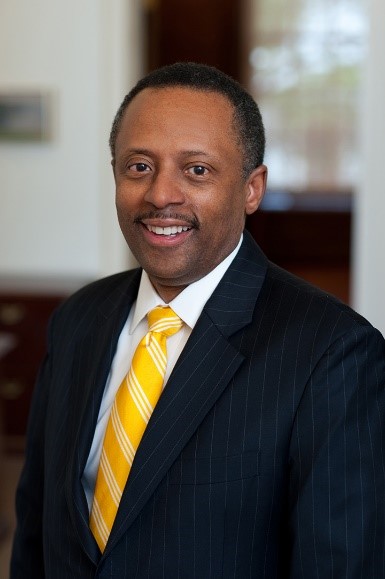 Born in Norfolk, Virginia, Earl Lewis came of age during the hard struggle for school integration in the South, and nationwide, that followed the landmark Brown v. Board of Education decisions (1954-1955). When Lewis studied at Concordia College between 1974 and 1978, the Civil Rights, Black Power, and Black Student Movements had already instigated momentous racial reform in the country’s colleges and universities. He participated in the Black Student Strike in the spring of 1976, a memorable marker in Concordia’s history as black student enrollments reached high tide before receding. Lewis’s academic achievements as an undergraduate anticipated a storied career as a scholar, administrator, innovator and entrepreneur, and leader in higher education. Serious and steady, yet affable and down-to-earth, Lewis embodies Concordia’s commitment to influence the world through studied preparation and dedicated service. Recipient of countless honors and awards, Lewis joined the college’s Board of Regents in 2008 and became chair in 2018. Born in Norfolk, Virginia, Earl Lewis came of age during the hard struggle for school integration in the South, and nationwide, that followed the landmark Brown v. Board of Education decisions (1954-1955). When Lewis studied at Concordia College between 1974 and 1978, the Civil Rights, Black Power, and Black Student Movements had already instigated momentous racial reform in the country’s colleges and universities. He participated in the Black Student Strike in the spring of 1976, a memorable marker in Concordia’s history as black student enrollments reached high tide before receding. Lewis’s academic achievements as an undergraduate anticipated a storied career as a scholar, administrator, innovator and entrepreneur, and leader in higher education. Serious and steady, yet affable and down-to-earth, Lewis embodies Concordia’s commitment to influence the world through studied preparation and dedicated service. Recipient of countless honors and awards, Lewis joined the college’s Board of Regents in 2008 and became chair in 2018.
|
 The construction of Park Region Hall in the mid-1950s as a women’s dormitory was part of Concordia’s response to increasing post-WWII student enrollment as well as the availability of government loans. From 1951 to 1955 the college’s enrollment increased by fifty-two percent, with 1354 students registered for the 1955-56 academic year. In addition to providing a new housing option for students, Park Region Hall experimented with a new form of residence governance that was eventually adopted across campus. In the twenty-first century the dormitory remains a place to test new ideas. During the 2016-2017 academic year Park Region was the first Concordia dormitory to offer a sexuality- and gender-inclusive floor.
The construction of Park Region Hall in the mid-1950s as a women’s dormitory was part of Concordia’s response to increasing post-WWII student enrollment as well as the availability of government loans. From 1951 to 1955 the college’s enrollment increased by fifty-two percent, with 1354 students registered for the 1955-56 academic year. In addition to providing a new housing option for students, Park Region Hall experimented with a new form of residence governance that was eventually adopted across campus. In the twenty-first century the dormitory remains a place to test new ideas. During the 2016-2017 academic year Park Region was the first Concordia dormitory to offer a sexuality- and gender-inclusive floor. 







